-

新人教版高中英语必修3Unit 5 The Value of Money-Reading for Writing教学设计二
2. 您能看到, 我头发太长了。You can see that my hair is much too long.3. 无论什么时候, 只要您想回来就回来。Please come back whenever you want.4. 您仅有很少的头发要理! You only have too little hair to cut !5. 为您服务是我的荣幸!It is my honour to serve you!Step 9 Writing(Henry is walking down the street when he sees a sign for a place that cuts hair. He decides to have it cut. )H=Henry B=BarberH: Good afternoon, I’d like to have my hair cut, if I may. (The barber looks at Henry’s hair and continues cutting another man’s hair. ) Er, I’d really like a haircut. As you can see it’s much too long. B: (in a rude manner) Yes, I can see that. Indeed, I can. H: Fine, well, I’ll have a seat then. (He sits in one of the barber’s chairs. The barber turns to look at Henry. )B: It’s quite expensive here, you know! Are you sure you can afford it?H: Yes. I think so. (After his hair is cut, the barber tells Henry how much he must pay. Henry shows the barber the bank note. )B: Why Mr. . . (looks shocked)H: Adams. Henry Adams. I’m sorry. I don’t have any change. B: Please don’t worry! (wearing a big smile) Nothing to worry about! Nothing at all! Please come back whenever you want, even if you only have too little hair to cut! It will be my honour to serve you!Step 10 Pair workExchange drafts with a partner. Use this checklist to help your partner revise his/her draft.1. Are all the elements of a play included and in good order ?2. Do the character use suitable language ?3. Are the stage directions clear and useful ?4. Is the plot clear and exciting enough ?

新人教版高中英语必修3Unit 5 the value of money-Reading For Writing教学设计一
【参考范文】Narrator:(Henry is smiling as he leaves the restaurant. As he is walking down the street, he sees a sign for a place that cuts hair. He decides to get it cut. )H=Henry;B=Barber;R=rude manH:Good afternoon, I'd like to get a cut, if I may. (The barber looks at Henry's hair and continues cutting another man's hair. )Er, I'd really like a haircut. As you can see it's much too long. B:(in a rude manner) Yes, I can see that. Indeed, I can. H:Fine, well I'll have a seat then. (He sits in one of the barber's chairs. The barber turns to look at Henry. )B:It's quite expensive here, you know!Are you sure you can afford it?H:Yes. I think so. (In comes the rude man. )R:Hey you there. I need a haircut quickly. Can you do me straightaway?B:All right, then, get in the chair and I'll see what I can do. R:Thank you. (sits down in one of the barber's chairs)H:Excuse me, but I was here first. Aren't you going to do my hair first?B:This man's in a hurry. H:Well so am I!I insist that you cut my hair first. B:OK, but I'll have to be quick. This gentleman is waiting. H:Thank you. (They both become quiet. After his hair is cut, the barber tells Henry how much he must pay. Henry shows the barber the bank note. )B:Why, Mr . . . (looks shocked)H:Adams. Henry Adams. I'm sorry, I don't have any change. R:You're that Mr Adams! Well,I'm glad I waited or I might never have known it was you. B:Why, Mr Adams, please don't worry!(wearing a big smile) Nothing to worry about!Nothing at all!Please come back any time, even if you only need too little hairs cut!It will be my honour to serve you!

新人教版高中英语选修2Unit 1 Science and Scientists-Discovering useful structures教学设计
The grammatical structure of this unit is predicative clause. Like object clause and subject clause, predicative clause is one of Nominal Clauses. The leading words of predicative clauses are that, what, how, what, where, as if, because, etc.The design of teaching activities aims to guide students to perceive the structural features of predicative clauses and think about their ideographic functions. Beyond that, students should be guided to use this grammar in the context apporpriately and flexibly.1. Enable the Ss to master the usage of the predicative clauses in this unit.2. Enable the Ss to use the predicative patterns flexibly.3. Train the Ss to apply some skills by doing the relevant exercises.1.Guide students to perceive the structural features of predicative clauses and think about their ideographic functions.2.Strengthen students' ability of using predicative clauses in context, but also cultivate their ability of text analysis and logical reasoning competence.Step1: Underline all the examples in the reading passage, where noun clauses are used as the predicative. Then state their meaning and functions.1) One theory was that bad air caused the disease.2) Another theory was that cholera was caused by an infection from germs in food or water.3) The truth was that the water from the Broad Street had been infected by waste.Sum up the rules of grammar:1. 以上黑体部分在句中作表语。2. 句1、2、3中的that在从句中不作成分,只起连接作用。 Step2: Review the basic components of predicative clauses1.Definition

新人教版高中英语选修2Unit 4 Journey Across a Vast Land教学设计
当孩子们由父母陪同时,他们才被允许进入这个运动场。3.过去分词(短语)作状语时的几种特殊情况(1)过去分词(短语)在句中作时间、条件、原因、让步状语时,相当于对应的时间、条件、原因及让步状语从句。Seen from the top of the mountain (=When it is seen from the top of the mountain), the whole town looks more beautiful.从山顶上看,整个城市看起来更美了。Given ten more minutes (=If we are given ten more minutes), we will finish the work perfectly.如果多给十分钟,我们会完美地完成这项工作。Greatly touched by his words (=Because she was greatly touched by his words), she was full of tears.由于被他的话深深地感动,她满眼泪花。Warned of the storm (=Though they were warned of the storm), the farmers were still working on the farm.尽管被警告了风暴的到来,但农民们仍在农场干活。(2)过去分词(短语)在句中作伴随、方式等状语时,可改为句子的并列谓语或改为并列分句。The teacher came into the room, followed by two students (=and was followed by two students).后面跟着两个学生,老师走进了房间。He spent the whole afternoon, accompanied by his mom(=and was accompanied by his mom).他由母亲陪着度过了一整个下午。

新人教版高中英语选修2Unit 1 Science and Scientists-Using langauge教学设计
This happens because the dish soap molecules have a strong negative charge, and the milk molecules have a strong positive charge. Like magnets, these molecules are attracted to each other, and so they appear to move around on the plate, taking the food coloring with them, making it look like the colors are quickly moving to escape from the soap.Listening text:? Judy: Oh, I'm so sorry that you were ill and couldn't come with us on our field trip. How are you feeling now? Better?? Bill: Much better, thanks. But how was it?? Judy: Wonderful! I especially liked an area of the museum called Light Games.it was really cool. They had a hall of mirrors where I could see myself reflected thousands of times!? Bill: A hall of mirrors can be a lot of fun. What else did they have?? Judy: Well, they had an experiment where we looked at a blue screen for a while, and then suddenly we could see tiny bright lights moving around on it. You'll never guess what those bright lights were!? Bill: Come on, tell me!? Judy: They were our own blood cells. For some reason, our eyes play tricks on us when we look at a blue screen, and we can see our own blood cells moving around like little lights! But there was another thing I liked better. I stood in front of a white light, and it cast different shadows of me in every color of the rainbow!? Bill: Oh, I wish I had been there. Tell me more!? Judy: Well, they had another area for sound. They had a giant piano keyboard that you could use your feet to play. But then, instead of playing the sounds of a piano, it played the voices of classical singers! Then they had a giant dish, and when you spoke into it, it reflected the sound back and made it louder. You could use it to speak in a whisper to someone 17 meters away.? Bill: It all sounds so cool. I wish I could have gone with you? Judy: I know, but we can go together this weekend. I'd love to go there again!? Bill: That sounds like a great idea!

新人教版高中英语选修2Unit 2 Bridging Cultures-Discovering useful structures教学设计
The grammar of this unit is designed to review noun clauses. Sentences that use nouns in a sentence are called noun clauses. Nominal clauses can act as subject, object, predicate, appositive and other components in compound sentences. According to the above-mentioned different grammatical functions, nominal clauses are divided into subject clause, object clause, predicate clause and appositive clause. In this unit, we will review the three kinds of nominal clauses. Appositive clauses are not required to be mastered in the optional compulsory stage, so they are not involved.1. Guide the students to judge the compound sentences and determine the composition of the clauses in the sentence.2. Instruct students to try to learn grammar by generalizing grammar rules, controlling written practice, and semi-open oral output.3. Inspire the students to systematize the function and usage of noun clause1.Instruct students to try to learn grammar by generalizing grammar rules, controlling written practice, and semi-open oral output.2.Inspire the students to systematize the function and usage of noun clauseStep1: The teacher ask studetns to find out more nominal clauses from the reading passage and udnerline the nominal clauses.

新人教版高中英语选修2Unit 3 Food and Culture-Reading and thinking教学设计
The discourse explores the link between food and culture from a foreign’s perspective and it records some authentic Chinese food and illustrates the cultural meaning, gerography features and historic tradition that the food reflects. It is aimed to lead students to understand and think about the connection between food and culture. While teaching, the teacher should instruct students to find out the writing order and the writer’s experieces and feelings towards Chinese food and culture.1.Guide the students to read the text, sort out the information and dig out the topic.2.Understand the cultural connotation, regional characteristics and historical tradition of Chinese cuisine3.Understand and explore the relationship between food and people's personality4.Guide the students to use the cohesive words in the text5.Lead students to accurately grasp the real meaning of the information and improve the overall understanding ability by understanding the implied meaning behind the text.1. Enable the Ss to understand the structure and the writing style of the passage well.2. Lead the Ss to understand and think further about the connection between food and geography and local character traits.Step1: Prediction before reading. Before you read, look at the title, and the picture. What do you think this article is about?keys:It is about various culture and cuisine about a place or some countries.
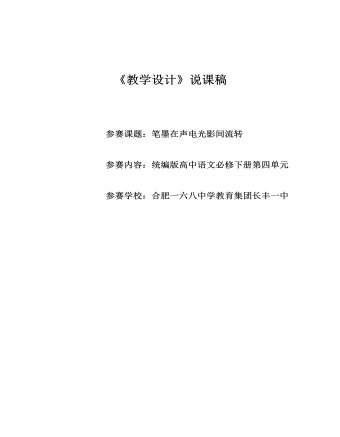
第四单元《教学设计》 说课稿 2021—2022学年统编版高中语文必修下册
(六)说教学策略1.专题性海量的媒介信息必须加以选择或者整合,以项目为依据,进行信息筛选,形成专题性阅读与交流;培养学生对文本信息“化零为整”的能力,提升跨媒介阅读与交流学习的充实感。2.情境化情境教学应指向学生的应用,建构富有符合时代气息的内容,与生活经验更加贴合,对学生的语言建构与运用有所提升,在情境中能够有效地进行交流。3.任务化以任务为导向的序列化学习,可以为学生构建学习路线图、学习框架等具体任务引导;或以跨媒介的认识与应用为任务的设置引导;甚至以阅读和交流作为序列化安排的实践引导。4.整合性跨媒介阅读与交流是结合线上线下的资源,形成新的“超媒介”,也能实现对信息进行“深加工”,多种媒介的信息整合只为一个核心教学内容服务。5.互文性语言文字是语文之生命,我们是立足于语言文字的探讨,音乐、图像、视频等文本与传统语言文字文本形成互文,触发学生对学习内容立体化和具体化的感悟,提升学生的审美能力。
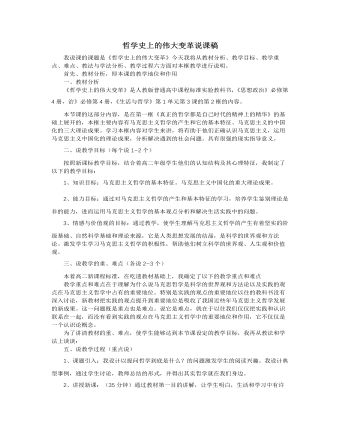
人教版高中政治必修4哲学史上的伟大变革说课稿(一)
2、讲授新课:(35分钟)通过教材第一目的讲解,让学生明白,生活和学习中有许多蕴涵哲学道理的故事,表明哲学并不神秘总结并过渡:生活也离不开哲学,哲学可以是我正确看待自然、人生、和社会的发展,从而指导人们正确的认识和改造世界。整个过程将伴随着多媒体影像资料和生生对话讨论以提高学生的积极性。3、课堂反馈,知识迁移。最后对本科课进行小结,巩固重点难点,将本课的哲学知识迁移到与生活相关的例子,实现对知识的升华以及学生的再次创新;可使学生更深刻地理解重点和难点,为下一框学习做好准备。4、板书设计我采用直观板书的方法,对本课的知识网络在多媒体上进行展示。尽可能的简洁,清晰。使学生对知识框架一目了然,帮助学生构建本课的知识结构。5、布置作业我会留适当的自测题及教学案例让同学们做课后练习和思考,检验学生对本课重点的掌握以及对难点的理解。并及时反馈。对学生在理解中仍有困难的知识点,我会在以后的教学中予以疏导。
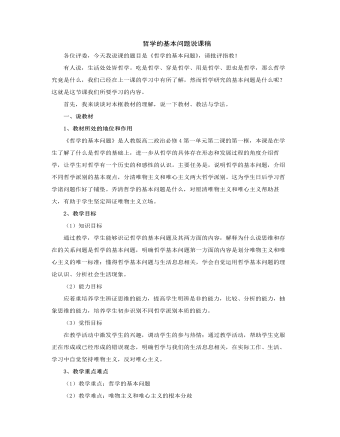
人教版高中政治必修4哲学的基本问题说课稿(二)
②关于哲学的第二个问题是——思维和存在有没有同一性解释同一性——就是说意识(思维)能否正确认识物质(存在)的问题。(让学生表达他们自己的意见)总结得出三种看法——认为意识(思维)可以正确认识物质(存在)的,属于可知论者;凡是认为意识(思维)不能正确认识物质(存在),属于不可知论者。当然也有些同学是两者观点都有,这种同学我们把他称为不彻底的不可知论者。2、为什么思维和存在的关系问题是哲学的基本问题(1)它是人们在生活和实践活动中首先遇到和无法回避的基本问题(举例说明问题,吃饭的时候吃什么菜,学习计划与学习的实际等等)结合教材P10探究进行讲解举例:11月31日请全班同学吃雪糕,吃完后再去肯德基大吃一顿,之后再到卡拉OK唱通宵——不切实际,因为11月并没有31日。(2)它是一切哲学都不能回避、必须回答的问题(不同的回答,直接决定着哲学的不同发展方向。)
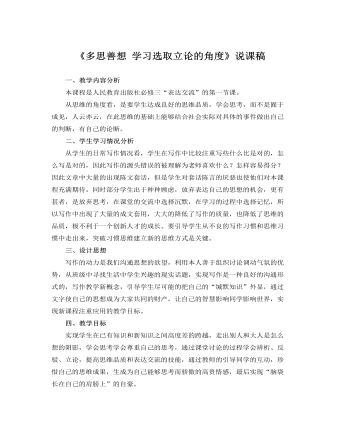
人教版高中语文必修3《多思善想 学习选取立论的角度》说课稿
谈到这,如果有人会说这仅仅是在于我个人与战场之上,战场之下另当别论,那么,他完全错了。在我小学四年级的语文课上有两个人发言积极,一个姓黄,一个姓康,黄同学发言比康同学更积极,班上的同学常以为黄同学是个了不得的人物,后来,教语文的吴老师曾悄悄地告诉我:班上真正厉害的是康x,那黄x没什么,说的全是“一点通”上的,照搬不误。说到这,我还得厚着脸皮自夸一下,在四年级时,我和康同学是同坐,一次,老师叫我们对一片课文(好象是写黄继光舍身炸暗堡)的一个段落提问题时,我悄悄地对康同学说了一个问题,康同学对我说:“你站起来说嘛。”内向的我遥遥头,康同学便站举手,并起来将我的问题大声地说了出来,结果老师说:“恩,康x的问题提得很好。”
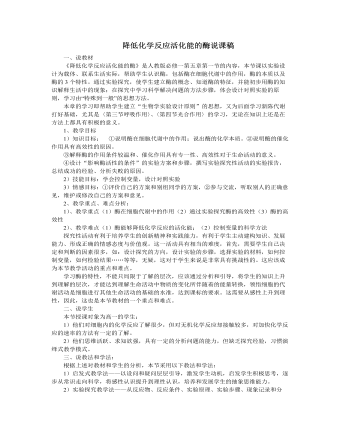
人教版高中生物必修1降低化学反应活化能的酶说课稿
实验是学习生物的手段和基础,是培养学生分析问题、解决问题的能力及创造能力的载体。新课程倡导:强调过程,强调学生探索新知识的经历和获得新知的体验,不能在让教学脱离学生的内心感受,必须让学生追求过程的体验。并且每年高考都有对生物学实验的考查,而且比例越来越重,而学生的失分比例大,主要在于他们没有完整的生物实验设计模式,考虑问题欠缺,本节安排在第二课时完整讲述高中生物学实验设计,是以学生在第一课时和前面探究实验接触的前提下,完整体验生物实验设计模式,为后面学习探究实验打下基础,也为培养学生分析问题、解决问题从一开始就打好基础。五、说教学过程:第一课时联系生活,导入新课,激发学生学习兴趣→细胞代谢→问题探究,酶在代谢中的作用,掌握科学实验方法→酶的本质,运用方法,自主归纳获取新知→小结练习,突出重点易化难点
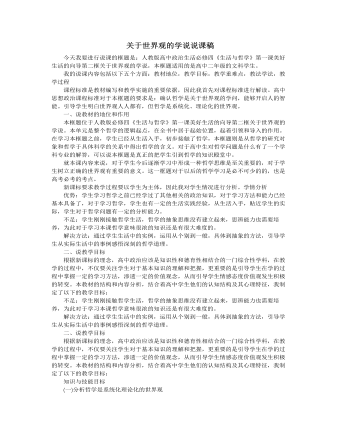
人教版高中政治必修4关于世界观的学说说课稿(一)
3、课堂小结,强化认识。(2—3分钟)通过总结本课的知识,简单的用三个概念三个关系,简明扼要的总结出本节课的知识,突出本框题的重难点。其中重点给学生梳理一下哲学的含义,使学生在学习的最后对于哲学有一个全面而准确的理解,强化学生对于哲学的认识。4、课堂练习针对高中学生初步接触哲学,运用哲学思维来分析哲学问题的能力还需要今后的培养,我进行了分层的方式来设计习题,这样设计一方面符合学生认知的能力,由简单到困难,一步步的深入,另一方面,在练习的过程中,也可以使学生巩固基础知识,使学有余力的学生继续提高,充分考虑到学生的实际情况。5、板书设计为了强化教学效果,我会在授课的过程中适时的书写板书,我的板书设计总的来说是以简洁明了的形式展示,便于学生一目了然的把握本节课的重难点,也可以建立知识间的联系,便于学生形成完整的知识体系。
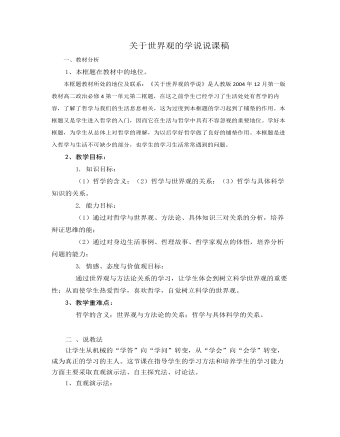
人教版高中政治必修4关于世界观的学说说课稿(二)
一、教材分析1、本框题在教材中的地位。本框题教材所处的地位及联系:《关于世界观的学说》是人教版2004年12月第一版教材高二政治必修4第一单元第二框题,在这之前学生已经学习了生活处处有哲学的内容,了解了哲学与我们的生活息息相关,这为过度到本框题的学习起到了铺垫的作用。本框题又是学生进入哲学的入门,因而它在生活与哲学中具有不容忽视的重要地位。学好本框题,为学生从总体上对哲学的理解,为以后学好哲学做了良好的铺垫作用。本框题是进入哲学与生活不可缺少的部分,也学生的学习生活常常遇到的问题。2、教学目标:1. 知识目标:(1)哲学的含义;(2)哲学与世界观的关系;(3)哲学与具体科学知识的关系。2. 能力目标:(1)通过对哲学与世界观、方法论、具体知识三对关系的分析,培养辩证思维的能;(2)通过对身边生活事例、哲理故事、哲学家观点的体悟,培养分析问题的能力;
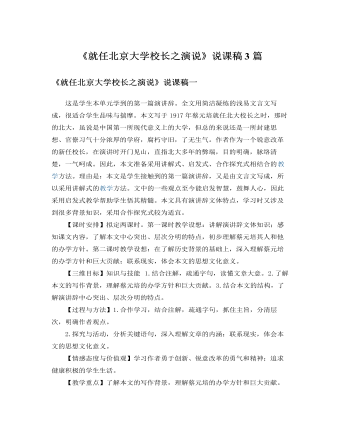
人教版高中语文必修2《就任北京大学校长之演说》说课稿3篇
(三)教学重、难点1、教学重点:结合课文,了解演讲辞针对性强、条理清楚、通俗易懂、适当的感情色彩等特点。2、教学难点:深入理解文章内涵,联系现实,体会本文的现实意义二、说学情高中学生在初中阶段已经接触过演讲辞了,对演讲词的特点已经有了一些基本的知识,因此本轮的教学应该让他们在此基础上有所提高。本文是学生在高中阶段第一次接触演讲辞,有必要让他们了解演讲辞的特点及课文如何体现这些特点的。随着年龄的增长,生活阅历的增加,高中学生正逐渐形成自己对世界、对人生的看法,蔡元培先生的这篇文章能很好地激发他们对当前的高中学习和未来的大学生活进行思考。此外,学生对北大的历史及蔡元培先生作这番演讲的时代背景了解不深,应作出补充说明。

人教版高中政治必修4哲学的基本问题说课稿(一)
五.说教学过程:(重点)1.课题引入:课堂探究导入新课。采用教材现成的探究活动导入新课,既“温故”又“知新”,还节约了课堂有效时间。2.讲授新课:(20-25分钟)本课的重难点是关于哲学基本问题的解释,我引用一个很著名的学生也略知一二的唯心主义观点的例子(课堂探究1)顺利进入本课重要知识点的学习,采用案例教学,激发学生的兴趣以及探究问题的欲望,学习哲学基本问题的第一个方面,并用问题和练习形式巩固知识,强化学生易错已混知识点;课堂探究2,同样引用哲学上的著名案例让学生分析探究思考以及合作交流,学生趣味浓厚,主动深入学习本课知识,达到预期教学目的。此时,本课的重点知识教学完成。关于本课的第二个知识点“为什么思维和存在的关系问题是哲学的基本问题”采用学生自主阅读、合作交流的方法,归纳总结,完成本知识目标。3.课堂反馈、知识迁移(10-15分钟)采用学生总结、随堂练习等形式巩固本课知识,同时检验教学效果。可使学生更深刻的理解教学重点。
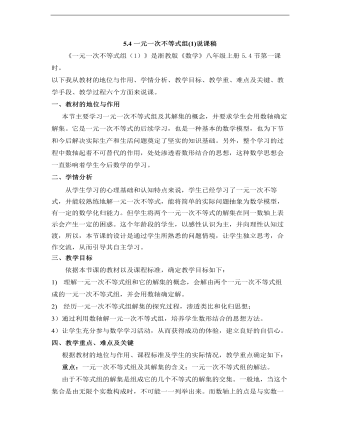
初中数学浙教版八年级上册《54一元一次不等式组(1)》说课稿
一、教材的地位与作用 本节主要学习一元一次不等式组及其解集的概念,并要求学生会用数轴确定解集。它是一元一次不等式的后续学习,也是一种基本的数学模型,也为下节和今后解决实际生产和生活问题奠定了坚实的知识基础。另外,整个学习的过程中数轴起着不可替代的作用,处处渗透着数形结合的思想,这种数学思想会一直影响着学生今后数学的学习。二、学情分析从学生学习的心理基础和认知特点来说,学生已经学习了一元一次不等式,并能较熟练地解一元一次不等式,能将简单的实际问题抽象为数学模型,有一定的数学化归能力。但学生将两个一元一次不等式的解集在同一数轴上表示会产生一定的困惑。这个年龄段的学生,以感性认识为主,并向理性认知过渡,所以,本节课的设计是通过学生所熟悉的问题情境,让学生独立思考,合作交流,从而引导其自主学习。
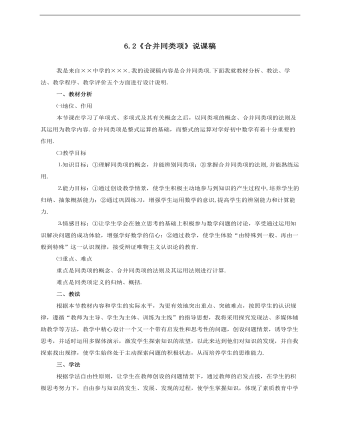
初中数学冀教版七年级上册《62合并同类项》说课稿
㈡教学目标⒈知识目标:①理解同类项的概念,并能辨别同类项;②掌握合并同类项的法则,并能熟练运用.⒉能力目标:①通过创设教学情景,使学生积极主动地参与到知识的产生过程中,培养学生的归纳、抽象概括能力;②通过巩固练习,增强学生运用数学的意识,提高学生的辨别能力和计算能力.⒊情感目标:①让学生学会在独立思考的基础上积极参与数学问题的讨论,享受通过运用知识解决问题的成功体验,增强学好数学的信心;②通过教学,使学生体验“由特殊到一般、再由一般到特殊”这一认识规律,接受辩证唯物主义认识论的教育.
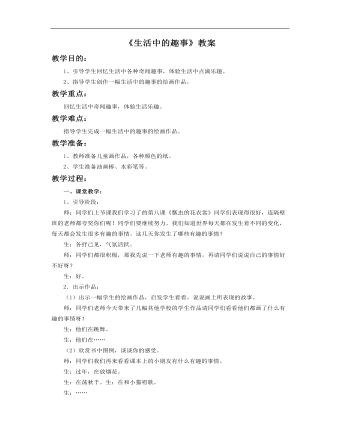
小学美术人教版一年级下册《第9课生活中的趣事》教案说课稿
一、课堂教学:1、引导阶段:师:同学们上节课我们学习了的第八课《瓢虫的花衣裳》同学们表现得很好,连隔壁班的老师都夸奖你们呢!同学们要继续努力。我们知道世界每天都在发生着不同的变化,每天都会发生很多有趣的事情。这几天你发生了哪些有趣的事情?生:各抒己见,气氛活跃。师:同学们都很积极,那我先说一下老师有趣的事情,再请同学们说说自己的事情好不好呀?
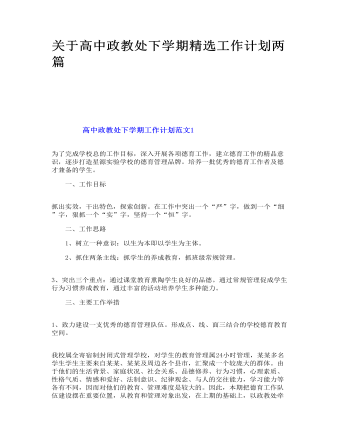
关于高中政教处下学期精选工作计划两篇
1、树立一种意识:以生为本即以学生为主体。 2、抓住两条主线:抓学生的养成教育,抓班级常规管理。 3、突出三个重点:通过课堂教育熏陶学生良好的品德。通过常规管理促成学生行为习惯养成教育,通过丰富的活动培养学生多种能力。

